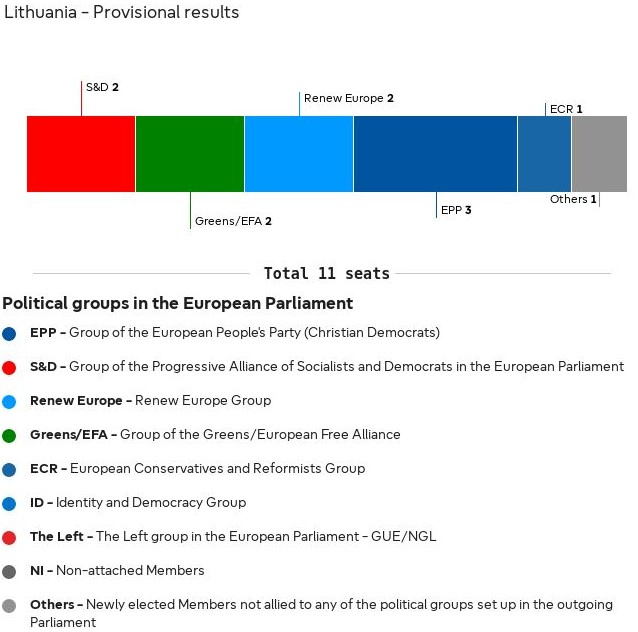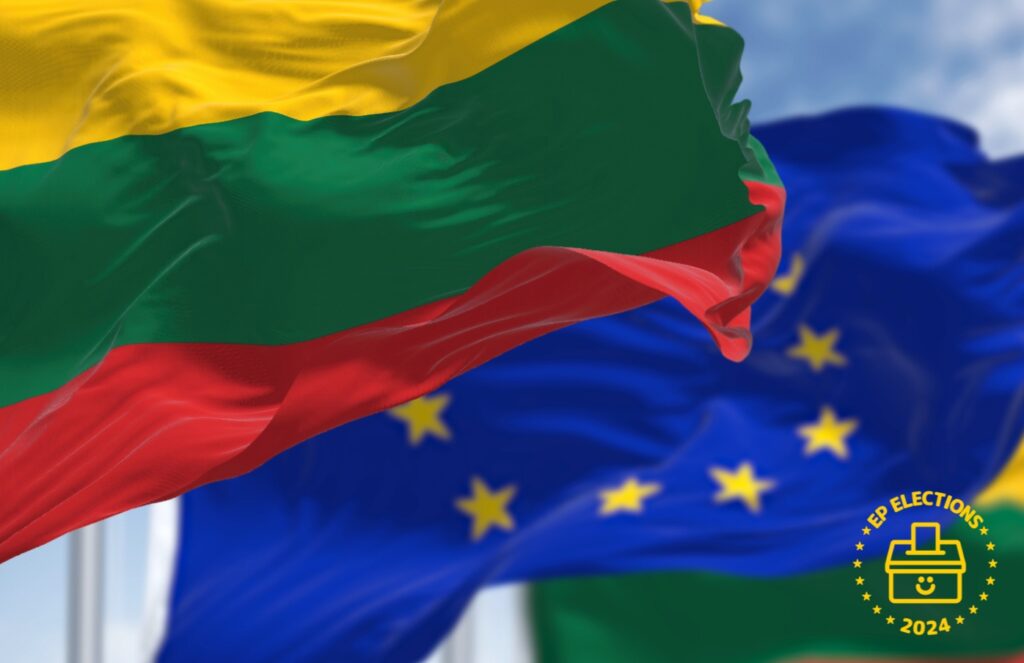Lithuania’s disinterest in the European Parliament led to an historically low turnout. The election outcome shows a relatively even distribution of votes among all parties and a generational divide.
In Lithuania, the European Parliament (EP) plays a relatively minor role, and the public often finds the political apparatus of the European Union (EU) complex and difficult to understand. Moreover, the work of MEPs is not well known in Lithuania. This is reflected in the historically low turnout in EP elections, which resulted in a relatively even distribution of votes among all parties.

Source: Verian for the European Parliament (https://results.elections.europa.eu/en/national-results/lithuania/2024-2029/)
Election Results: A Snapshot
The 9 June elections saw a turnout of around 28%, with a relatively even distribution of votes between the parties, resulting in the following mandates:
- The Homeland Union – Lithuanian Christian Democrats and the Social Democrats secured three and two mandates, respectively.
- The following parties each received one mandate:
- Union of Democrats “For Lithuania”
- Freedom Party
- Liberal Movement
- Lithuanian Farmers and Greens Union
- Electoral Action of Poles in Lithuania – Christian Families Alliance
- People and Justice Union
- The newly formed radical right-wing party, the National Alliance, passed the threshold to receive state funding but did not secure any mandate. The conservative party’s focus on security, emphasising “a safe Lithuania and a safe Ukraine”, resonated with voters and secured it the largest number of seats.
Analysis of the Party Election Campaigns
The Lithuanian Social Democratic Party
The Lithuanian Social Democrats, allied to the Progressive Alliance of Socialists and Democrats (S&D) in the EP, ran an interesting campaign. Vilija Blinkevičiūtė, the party’s leader since 2021, focused mainly on her work in the EP. The significantly higher salary of an MEP compared to national positions may have influenced her preference for working at the European level.
For the first time, the Social Democrats had not nominated a candidate for the Lithuanian presidential elections in May, instead supporting the right-wing populist President Gitanas Nausėda. They hoped that winning the president’s favour would be beneficial, given his strong chances of re-election. However, the party did not actively campaign alongside him. Blinkevičiūtė has not clarified whether she will remain in the EP or become prime minister if elected, creating uncertainty among voters. This lack of clarity could reduce her support in the upcoming Seimas (Lithuanian parliament) elections to be held in October. Despite this, the media, polls and political scientists are predicting a victory for the Social Democrats in the October’s election. This situation suggests two possibilities: the party is either overly reliant on favourable polls or has become too dependent on Blinkevičiūtė, potentially jeopardising its standing in the next elections.
Conservative Party
The Homeland Union – Lithuanian Christian Democrats (TS-LKD), part of the ruling majority and winners of the 2020 Lithuanian parliamentary elections, belong to the European People’s Party (EPP) group in the European Parliament. They have a strong, loyal electorate, humorously described on social media as willing to vote in any weather, at any time. Despite its secure base, the party actively campaigned through social media, posters and other materials, unlike the more passive Social Democrats.
Lithuanian Greens and Union of Democrats For Lithuania
The Lithuanian Green Party and the Union of Democrats “For Lithuania” both position themselves as centre-left parties with a focus on environmental issues. The Union of Democrats is a member of the European Green Group in the European Parliament, while the Green Party is not, having been founded by Lithuanian businessmen. The Greens focused on environmental issues, but neglected socio-economic issues, which may have affected their influence on voters. The Union of Democrats campaigned on the popularity of European Commissioner Virginijus Sinkevičius and former Seimas speaker Saulius Skvernelis.
Liberal parties
Lithuania’s liberal parties, the Freedom Party and the Liberal Movement, are part of the Renew Europe group.On the eve of the European Parliament elections, the ‘LT PRIDE’ march for LGBTQ+ and human rights took place in Vilnius. The participation of the Freedom Party is likely to have boosted its vote, in line with its human rights-oriented electorate. Conversely, the Liberal Movement ran a more passive campaign.
Other conservative and Christian parties
The Lithuanian Farmers and Greens Union, currently a member of the European Greens, is expected to leave this grouping due to its approach to environmental protection and its business links. Several Christian conservative parties, which oppose the ruling party on LGBTQ+ rights and other issues, are likely to have gained support from public irritation over the ‘LT PRIDE’ march.Their populist campaign criticised the ruling majority, the EU’s stance on LGBTQ+ rights and environmental protection, appealing to voters opposed to these issues.
Conclusion
The Lithuanian election results indicate a continued pro-European stance, with both the Social Democrats and the Conservatives aligning themselves with the pro-European factions. However, concerns remain about the quality of the MEPs sent to the EP, with one inactive for five years and another newly elected right-wing populist with a criminal record. This trend is worrying, but also removes these individuals from the national political scene for the next five years, potentially leading to a more productive national parliament.
The voting patterns reflect a generational divide, with young people focusing on securing their future, environmental issues, affordable housing and human rights, while the older generation prioritises lower taxes, traditional values and security. This divide is evident in the support for progressive versus conservative parties.
Overall, the elections underline the complexity and evolving dynamics of Lithuania’s political landscape within the broader context of the European Union.
Cover Image: Rarrarorro via Istock by Getty Images.



